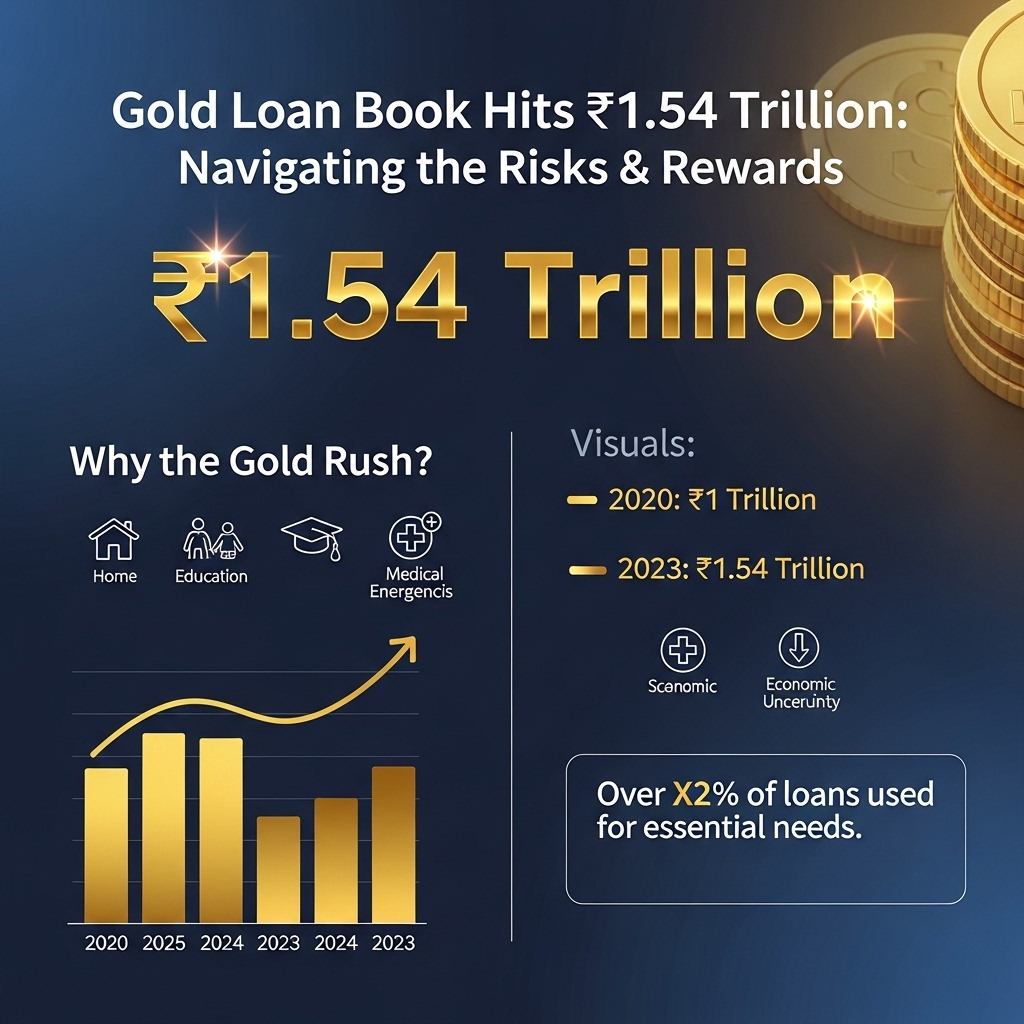The Golden Paradox: Unpacking the ₹1.54 Trillion Gold Loan Boom
In an economic landscape often characterized by volatility and shifting sands, gold has consistently proven its mettle as a resilient store of value and a beacon of financial security. Savvy investors worldwide continue to gravitate towards its timeless appeal, leveraging its stability to diversify portfolios and hedge against inflation. However, beyond traditional investment avenues, a fascinating and rapidly expanding trend is reshaping how gold interacts with the broader financial system: the gold loan market. Recent reports reveal a staggering milestone – the gold loan book in India has surged to an unprecedented ₹1.54 trillion, a figure that demands attention from every gold enthusiast and investor.
This colossal sum signifies that a substantial portion of the nation’s privately held gold is now collateralized, bringing forth both opportunities and inherent risks. For investors passionate about gold’s enduring value and keen on understanding market trends, this development is more than just a statistic; it’s a vital indicator of underlying economic pressures, consumer behavior, and potential systemic vulnerabilities. Our deep dive will unravel the complex implications of this financial phenomenon. We’ll explore who benefits from this booming gold loan sector – from individual borrowers accessing quick liquidity to the financial institutions facilitating these loans – and critically examine the potential financial risks involved for all stakeholders. Understanding the intricate dance between gold’s intrinsic value and its role as leverage in the credit market is paramount for making informed investment decisions and navigating the future landscape of gold finance.
Gold Market Analysis and Key Insights
Rising Gold Loan Portfolio Concerns
India’s gold loan book reaching ₹1.54 trillion signals significant exposure in the precious metals lending space. This growth reflects increased retail participation in gold-backed financing, particularly among middle-class households using jewelry as collateral. The concentration risk remains high, as economic downturns or sharp gold price corrections could trigger widespread defaults, impacting both lenders and borrowers.
Current Market Dynamics and Pricing Trends
Gold prices have exhibited volatility in recent months, influenced by global monetary policy shifts, geopolitical tensions, and rupee fluctuations. The domestic market shows strong correlation with international benchmarks, with premiums reflecting robust demand during festive seasons. However, rising interest rates have somewhat tempered investment enthusiasm, creating a complex environment for gold loan portfolios.
Investment Benefits and Risk Assessment
Gold continues offering portfolio diversification and inflation hedging benefits, particularly during economic uncertainty. However, investors should consider opportunity costs, storage expenses, and price volatility. The metal lacks income generation capabilities, making it primarily a capital appreciation asset. Market timing becomes crucial given price swings.
Expert Recommendations for Investors
Financial advisors suggest limiting gold allocation to 5-10% of total portfolios, emphasizing systematic investment approaches over lump-sum purchases. Experts recommend monitoring loan-to-value ratios carefully, as high leverage amplifies risks during price declines. Diversification across asset classes and regular portfolio rebalancing remain essential strategies for managing gold-related exposures effectively.
The growing gold loan market requires careful oversight and prudent risk management practices to prevent systemic financial vulnerabilities while maintaining gold’s role as a traditional wealth preservation tool.

Gold Investment Strategies and Options
Understanding sound gold investment strategies is crucial for financial resilience, offering various avenues. Physical gold (jewelry, coins, bars) offers tangible ownership and cultural value but entails storage, security, and purity concerns, alongside potential making charges affecting liquidity.
Alternatively, paper or digital gold options offer exposure without physical possession. Gold Exchange Traded Funds (ETFs) provide liquidity, mirroring prices. Gold mutual funds invest in related assets. Sovereign Gold Bonds (SGBs), government-issued, are highly attractive, offering fixed interest, tax efficiency on maturity, and eliminating storage risks. Digital gold platforms also allow small purchases.
For risk assessment and portfolio allocation, gold typically serves as a hedge against inflation and uncertainty. Allocating 5-15% of a portfolio to gold is often recommended for diversification, mitigating overall volatility based on risk tolerance.
Comparing methods, SGBs offer interest and tax benefits, ETFs ease of trading, and physical gold tangible appeal despite challenges. Market timing is less critical than for equities; gold is a long-term strategic asset. Dollar-cost averaging, investing fixed amounts regularly, can smooth price fluctuations.
Ultimately, the best gold investment strategy aligns with individual financial goals, risk appetite, and liquidity needs, serving as a valuable component in a diversified portfolio.
Market Performance and Outlook
The Indian gold loan market has exhibited remarkable resilience and consistent growth over the past decade, historically serving as a crucial financial safety net. Its recent monumental expansion, culminating in a ₹1.54 trillion valuation, underscores its current significance in the financial landscape. This surge is primarily driven by persistently high gold prices, which enhance loan-to-value ratios, making gold a more attractive and viable collateral. Concurrently, a tighter conventional credit environment and a sustained demand for quick, accessible liquidity from both retail and small and medium enterprise (SME) segments have significantly bolstered the appeal and uptake of gold-backed financing.
Looking ahead, the gold loan market’s future trajectory is intricately linked to prevailing macroeconomic conditions and the inherent volatility of gold prices. Key economic factors influencing gold’s value include global inflation trends, interest rate policies by central banks, and geopolitical stability. Sustained inflationary pressures often bolster gold’s appeal as a hedge, potentially driving its price higher and supporting the loan book’s collateral value. Conversely, aggressive global interest rate hikes could diminish gold’s attractiveness, potentially leading to price corrections.
Predictions suggest continued, albeit possibly moderated, growth in the near term as economic uncertainty persists, making gold loans a preferred rapid credit option. However, lenders face the critical risk of a sharp decline in gold prices, which could significantly erode collateral value and increase default risks for borrowers. Prudent monitoring of gold price volatility and diligent assessment of borrower repayment capacity will be essential for maintaining financial stability within this rapidly expanding sector.
Frequently Asked Questions About Gold Investment
What does a ₹1.54 Trillion gold loan book signify?
It represents a substantial volume of loans backed by gold, increasing lender exposure to gold price volatility and borrower repayment capacity. It highlights gold’s growing use as credit collateral.
Who is primarily at financial risk from such a large gold loan book?
Both borrowers and lenders. Borrowers risk losing their gold if they default or prices fall. Lenders face potential non-performing assets (NPAs) if widespread defaults occur and auctioned gold doesn’t cover loans.
How does this impact my personal gold investments?
Indirectly. Your physical gold’s value remains stable, but widespread loan defaults could lead to lenders selling collateral, potentially causing temporary, localized downward price pressure.
Should I be concerned about gold’s stability as an investment asset?
No. Gold’s fundamental role as a safe-haven and inflation hedge is separate from loan market risks. The loan book size reflects credit activity, not gold’s intrinsic long-term value.
What are the key risks for individuals taking a gold loan now?
Main risks are gold price volatility, potentially triggering margin calls or loss of pledged gold if prices drop. Repayment capability amidst fluctuating personal finances is also crucial.
How can I mitigate risks if I have or plan to take a gold loan?
Ensure a clear repayment strategy and emergency funds. Monitor gold prices, understand your Loan-to-Value (LTV) ratio and interest rates. Borrow conservatively, ensuring repayment is feasible.

Final Thoughts on Gold Investment
The staggering ₹1.54 trillion gold loan book serves as a powerful reminder of gold’s dual role: a critical asset for liquidity and a potential indicator of underlying financial strain. For gold investors, this trend underscores the metal’s enduring value as collateral, but also signals a need to monitor broader economic health that drives such high loan volumes. It emphasizes that while gold is a safe haven, the ecosystem around it is dynamic and influenced by economic pressures.
Our final recommendation for gold investors is to maintain a diversified portfolio with a strategic allocation to physical gold or gold ETFs as a long-term store of value. Avoid speculative plays driven by short-term loan trends. Instead, view gold as a foundational element for wealth preservation during times of uncertainty. Equip yourself with knowledge, consult a trusted financial advisor, and position your portfolio to weather economic shifts effectively. Your financial future deserves a well-informed approach.